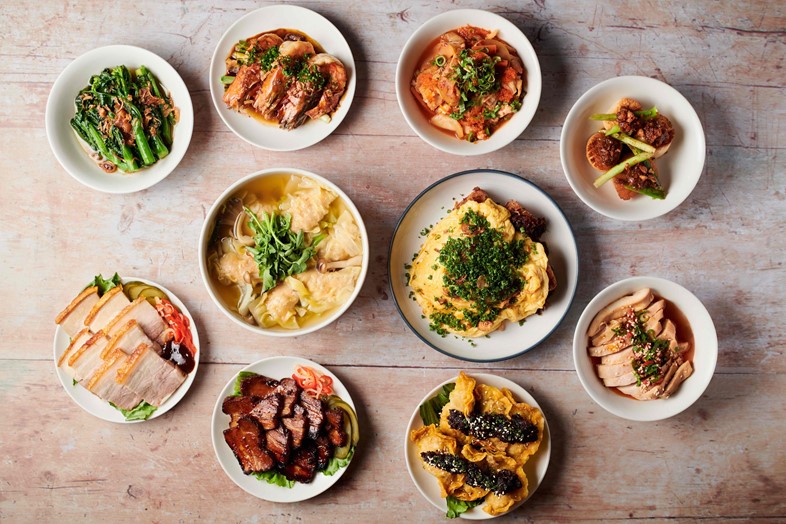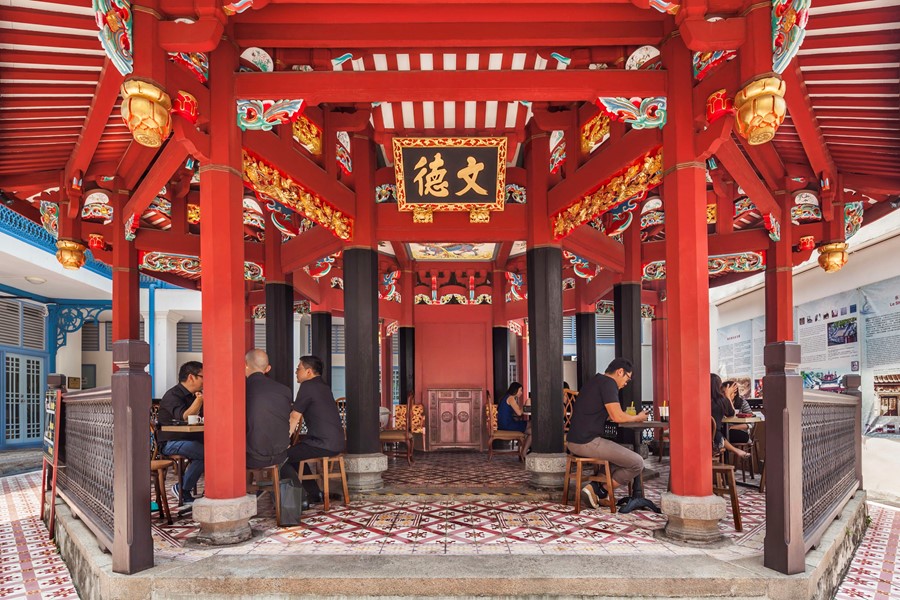With a population comprising three main ethnic groups (Chinese, Malay and Indian), Singapore has a vibrant mix of modern and traditional cuisine. Here, we give you a guide to the best places to eat
Introducing a series of alternative city guides, specially curated for the cultivated traveller.
After decades of ascendancy, Singapore is now widely considered to be Asia’s premier global city. It has more than its fair share of high-end dining, as you’d expect from a top financial centre, and boasts 52 Michelin-starred restaurants. But its traditional food culture has endured to a remarkable extent: Singapore is hyper-modern and feels a little sci-fi, but its cuisine is an anchor to the past. This sense of continuity is most evident in its hawker centres – community dining rooms which feature a range of vendors and stalls, many of which specialise in one dish. Because these recipes have often been honed across multiple generations, even the most humble of establishments offer a high level of technical mastery. Increasingly, food halls in the West are touting themselves as ‘Hawker-style’, but they rarely capture the unique atmosphere of bustling, communal informality. In 2020, UNESCO added Singapore’s hawker culture to its ‘Representative List of the Intangible Cultural Heritage of Humanity’, partly because of the integral role they play in the nation’s community – it’s normal to eat at these centres every evening and they are frequented by a broad section of society.
With a population comprising three main ethnic groups (Chinese, Malay and Indian, in descending order of size,) Singapore is a fascinating mixture of cultures and traditions. This diversity is reflected in the visual landscape: you’ll find skyscrapers looming over low-rise streets of candy-coloured vernacular architecture; mosques, Hindu temples, Buddhist shrines and dainty little colonial churches. It’s also one of the greenest cities on the planet, with lush avenues lined with yellow flame trees and bougainvillaeas, and scores of high-rise buildings clad in greenery or interrupted with vertical gardens. Of the many reasons to recommend it, the food culture is a stand-out.
Below is a guide to some of the city’s highlights, from modern to traditional.

Hill Street Tai Hwa Pork Noodle
Founded in the 1930s, this stall became one of the first two street food locations in the world to be awarded a Michelin Star. You can expect long queues, but in Singapore this is usually a sign of local endorsement (despite its global renown, Hill Street has managed to avoid becoming a tourist trap.) Located down a side street in the middle of a housing estate, it’s fairly unassuming, although its neon lights and plastic furniture are atmospheric in their own way.
I had the signature dish of bak chor mee: flat yellow noodles with mince, pork, shallots and liver (offal is a more common ingredient in Singapore cuisine than it is in Britain, and I was pleasantly surprised by how appealing its texture is.) I also enjoyed the sole bites, which are like crunchy pork scratchings made with fish.
JAAN by Kirk Westaway
At the opposite of the spectrum to the hawker markets sits JAAN by Kirk Westaway, a two Michelin-starred restaurant which serves modern British cuisine – most of the ingredients are sourced from the UK and Ireland. Since 2015, it has been headed up by Kirk Westaway, a celebrated chef who draws inspiration from his upbringing in Devon.
This influence finds expression in JAAN’s excellent tasting menu, featuring wild sea bass, langoustine and Welsh crab, among others. While some of the dishes are deceptively simple, every element feels perfectly calibrated. My favourite was the poached hen’s egg, which is served alongside caviar and a bright-green stinging nettle sauce. JAAN is located at the top of Swissotel The Stamford Hotel and the view is genuinely breathtaking: hundreds of ships and tankers dotted across a green sea; the space-age decks of the Marina Bay Sands report and the gargantuan ‘super-trees’ which sit behind it.
Tiong Bahru
Mostly comprising 1930s art-deco housing, Tiong Bahru is leafy, elegant and one of the most fashionable areas of Singapore. There are plenty of modern cafes: at the Tiong Bahru Bakery, you’ll find French pastries, iced drinks and a range of quirky merchandise. But there are just as many traditional establishments, many of which serve congee – a rice-based, savoury dish which is sometimes referred to as “porridge” but bears little resemblance to its British equivalent. One of the district’s most charming features is a series of murals by contemporary artist Yip Yew Chong whose work depicts ordinary life in the 1970s: street food stalls, fortune tellers and the interior design of a typical apartment. They are sentimental and sweet, like Singapore’s answer to Norman Rockwell.
The heart of the neighbourhood is the Tiong Bahru Market, a hawker centre and food market situated inside a striking art deco building. As well as food products, the market offers a range of traditional crafts. One of the highlights is a stall which sells “Zhizha” products: paper gifts that you buy for your dead loved ones and then burn as part of a Taoist ceremony, which allows them to be received in the afterlife. While it’s an ancient tradition, the range of gifts on offer is modern and charmingly idiosyncratic, including cars, Gucci handbags, karaoke machines, petrol stations and sewing machines.

Analogue
Analogue is a 100% plant-based restaurant in Chijmes Square, a bustling dining complex which features live music and looks out onto Singapore’s most historically significant church. Analogue’s commitment to sustainability is reflected in both the menu and the interior design. In keeping with Singapore’s eco-futurist vibe, the bar is 3D-printed from recycled plastic bottles and the tables are made from mycelium spores (i.e. mushrooms). The menu offers some of the most convincing imitation meat I’ve ever tasted: the plant-based chicken nuggets and the jackfruit tacos were fantastic.
Killiney Kopitiam, Lorong Telok
Dating back to 1919, Killiney Lorong is the oldest Hainanese coffee shop in Singapore. There are now dozens across the island but this is the original branch and its setting – next to the harbour and down a street of colourful low-rise houses – is especially picturesque.
Killiney Lorong serves cooked food throughout the day, but I visited for a traditional breakfast of sweet toast, kaya (a green, custard-like condiment made from coconut milk) and soft-boiled eggs. Time-starved Singaporeans – particularly of the older generation – sometimes mix their morning egg into their coffee and down it as a shot, but I didn’t work up the courage to give this a try.
Rempapa
Situated in a modern complex to the east of the city, Rempapa is the brain-child of Damian D’Silva – a judge on Singapore’s MasterChef. The design is light and airy, featuring mid-century furniture and vintage hanging lights; it feels like a 1960s diner but with a glossy modern sheen.
While Singapore is incredibly diverse, the food cultures of its constituent communities are mostly distinct. This restaurant, in contrast, offers a fusion of the island’s cuisine. It combines Malay, Chinese, Peranakan and Indian influences, while borrowing the occasional element from European dishes. The Spanish mackerel, cooked over five hours and marinated overnight, was delectable, as was the singgang, a spicy dish made with unboned wolf-herring fish. The desserts are also a must-try, with one of the highlights being a Malay dish called posui – a surprisingly salty jelly with coconut shavings.

Lau Pa Sat Hawker Centre
There are hundreds of hawker centres across Singapore, and most of them are fairly modest (which is part of their charm.) Lau Pa Sat Hawker, however, is one of the more impressive destinations. It’s situated inside one of the oldest Victorian structures in South-East Asia, with cast-iron ceilings and a majestic clock tower perched on the roof.
Considering its location in the middle of the financial district, dwarfed on all sides by gleaming skyscrapers, Lau Pa Sat is astonishingly cheap. The range of food on offer is as vast as any hawker centre, and the quality as consistent, but I would recommend Satay Street, a line of open-air grills serving up the best skewers on the island, and any of the stalls selling grilled prawns.
Joo Chiat & Katong
These side-by-side neighbourhoods boast some of Singapore’s most picturesque streets. On Koon Seng Road, you’ll find rows of elaborately-adorned, pastel-coloured houses that are so adorable it’s hard to believe they’re real – it’s like stumbling into a Wes Anderson dream world.
There are plenty of great food options in the area, but 328 Katong Laksa is a must-visit (you will be following in the footsteps of Gordan Ramsay, whose photograph adorns the walls.) The restaurant is justifiably renowned for its prawn and noodles Laksa, which is the best I’ve ever tried: creamy, rich and just the right level of spicy. After you’ve eaten, make sure to check out the Hindu temple just around the corner.
Keng Eng Kee
From its humble beginnings as a street stall in 1970, Keng Eng Kee has become one of Singapore’s most celebrated restaurants (Anthony Bourdain was a big fan). Despite its renown, it’s unfussy and down-to-earth, both in its aesthetics and atmosphere.
Seafood is its big speciality. The laksa, with fresh cockles, prawns and powdered dry shrimp, was incredible, but my highlight was the chilli crab – an iconic Singapore dish which is cooked here to perfection. It’s a messy dish (when you’re handed a bib, you know you’re in for a good time), which adds to the fun: there’s something liberating about realising there’s no elegant way to eat something and fully committing yourself to ending up covered in sauce. The coffee pork ribs were also delicious – almost disconcertingly sweet, like eating a rich caramel cake that happened to be made of meat.
Raffles Long Bar
The Raffles Hotel remains one of the most evocative remnants of Victorian-era Singapore, with its old-world decor, vintage ceiling fans and eccentric traditions: there are bags of monkey nuts on every table and you are encouraged to chuck the shells on the floor, which makes walking around a satisfyingly crunchy experience.
Raffles is the home of the world-famous Singapore Sling, a gin-based cocktail made with pineapple juice, curacao and benedectine. Behind its creation lies an inspiring act of male allyship: In 1915, when it was frowned upon for women to drink alcohol, an enterprising bartender invented the drink (which resembles a fruit punch) as a way for women to get drunk on the sly.
